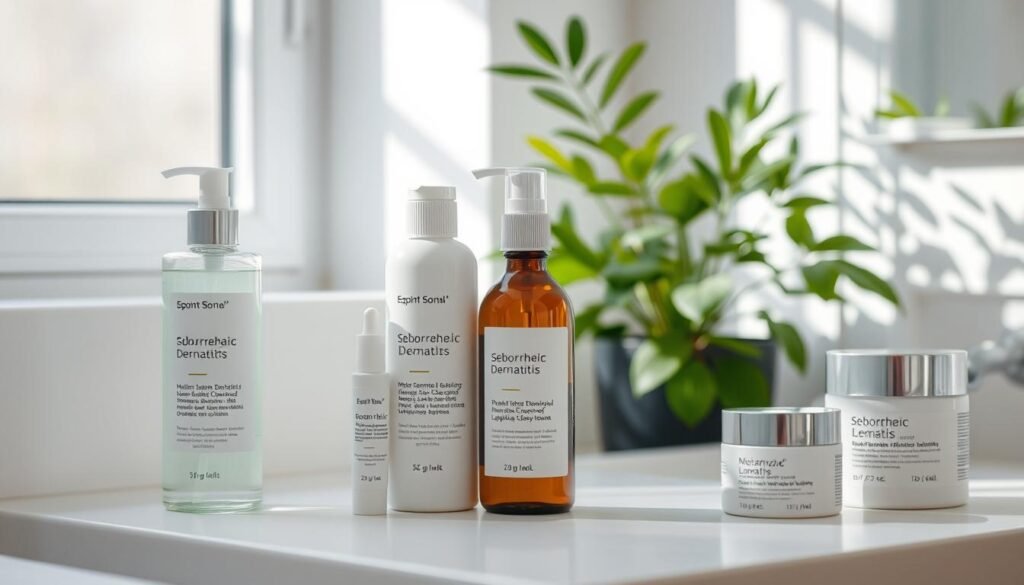Did you know about 3% of Americans face seborrheic dermatitis at some time? This skin issue mostly hits oily spots on the body, causing flaky skin and ongoing dandruff. Knowing what triggers seborrheic dermatitis flare-ups is key to managing it well. By focusing on these triggers, people can better their skin health and lessen discomfort.
Common signs of this condition are scaly patches, discomfort, and redness. Many things like stress, hormonal shifts, and diet can make these worse. Addressing these triggers helps not just with daily comfort but also in stopping worse cases later. Taking a full approach in managing seborrheic dermatitis leads to healthier skin and a higher quality of life. For further details on handling this condition, visit seborrheic dermatitis.
Key Takeaways
- Approximately 3% of Americans experience seborrheic dermatitis.
- This condition predominantly affects oily areas, including the scalp and face.
- Identifying triggers is vital for effective management and symptom relief.
- Common triggers include stress, hormonal changes, and dietary factors.
- Proper skin health tips can aid in preventing flare-ups.
Understanding Seborrheic Dermatitis
Seborrheic dermatitis affects about 1% to 3% of people everywhere. It’s more common in individuals with weakened immune systems, hitting a high of 34% to 83%. The condition mainly shows up in oily areas like the scalp and face. It’s crucial to know about this skin issue since it mostly impacts babies and adults between 30 to 60 years old.
The disorder has two peak times: early in life and then in the teenage years into early adulthood. Men get it more often, and it’s worse in cold, dry weather or when stressed. Understanding this helps in managing it better.
Symptoms vary with age and race. Babies usually get cradle cap, while adults might have dandruff or face rashes. Knowing these differences makes managing the condition easier. Treatments like ketoconazole are effective. Studies also praise pimecrolimus for tough cases.
Overgrowth of Malassezia yeast on skin might cause the condition. Recognizing and treating seborrheic dermatitis effectively needs awareness. This underlines the value of personalized care and knowing your treatment options.
| Factor | Description |
|---|---|
| Prevalence | 1% to 3% in general; 34% to 83% in immunocompromised individuals |
| Age Distribution | Peaks at 2-12 months, and again in adolescence to early adulthood |
| Gender Differences | More common in men |
| Environmental Impact | More severe in cold, dry climates |
| Treatment Options | Includes ketoconazole, pimecrolimus, and fluconazole |
Symptoms of Seborrheic Dermatitis
It’s important to spot the signs of *seborrheic dermatitis* early. People often see flaking skin or dandruff on their scalp or shoulders. This looks like small white flakes. The face, especially around the nose and ears, might show greasy skin patches. These come with yellow or white scales. You’ll see this on the scalp too.
These areas can get red or inflamed, and it looks different on various skin colors. For those with darker skin, the change in color is more noticeable. When scratched, these spots can become more irritated. This can even lead to sores.
One common complaint is itchiness. This itch can be so annoying. It leads people to scratch, which might harm the skin and cause hair loss. This happens because the follicles get damaged.
About 3% to 12% of people deal with seborrheic dermatitis. This condition strikes both babies and adults. If you catch and treat the symptoms early, it can really help. People’s lives get much better when they manage this issue well.
Triggers of Seborrheic Dermatitis Flare-Ups
Seborrheic dermatitis flare-ups come from many factors. These can be things we can’t control and our surroundings. Knowing what triggers flare-ups is key to handling and preventing them. About 3% to 12% of people deal with this, so it’s pretty common.
Figuring out why flare-ups happen lets people find better ways to care for their skin.
Common Symptoms Experienced
The symptoms linked to seborrheic dermatitis often include:
- Red, scaly patches on the scalp and face
- Itching or burning sensations
- Flaky, oily skin
- Yellowish crusts, especially in infants
People with oily skin or a family history of this condition tend to get these symptoms more. Stressful events can make flare-ups worse too.
Seasonal Influences on Flare-Ups
Seasonal changes also affect seborrheic dermatitis. Many notice more problems in cold weather, as it dries out skin. Cold air makes dry skin worse, leading to more flare-ups. This shows that managing seborrheic dermatitis means watching out for seasonal changes too.
Stress and Its Impact
Stress plays a big role in seborrheic dermatitis flare-ups. It’s clear how stress and seborrheic dermatitis are linked. Many people say stress triggers their skin issues. A huge 82% of patients have flare-ups on their scalp when stressed. Stress weakens the immune system. This makes people more sensitive to things that worsen their condition.
How Stress Triggers Flare-Ups
Lots of people blame stress for their seborrheic dermatitis. Many noticed that stress events led to worse skin problems. This condition’s mental impact is big. 11% faced serious psychological effects. 20% had moderate and 35% had mild effects. Having it on your face can make depression worse, says the Beck Depression Index. If you link flare-ups to stress or feel very anxious, you might get more flare-ups.
Stress Management Techniques
Using good stress management techniques is key for handling seborrheic dermatitis. Relaxing more can really help control flare-ups. Here are some good methods:
- Regular physical activity: Yoga and other exercises help with stress and make you feel better.
- Journaling: Writing helps you understand your feelings and what stresses you.
- Mindfulness meditation: This helps you relax and think clearly, fighting stress-related problems.
Making these techniques part of your everyday life can help manage stress. This improves your skin health if you have seborrheic dermatitis.

The Role of Diet and Nutrition
Diet plays a key role in managing seborrheic dermatitis. What you eat can affect your skin health. It’s vital to know which foods are good or bad for you. Some foods might trigger symptoms, while others could help. By understanding this, you can adapt your diet to better deal with seborrheic dermatitis.
Foods to Avoid
Certain foods might make seborrheic dermatitis worse. A study showed that people saw more skin issues when they ate:
- Spicy foods – 16.9%
- Sweets – 16.9%
- Fried foods – 13.5%
- Dairy products – 11.9%
- Citrus fruits – 10.2%
This shows a link between these foods and more frequent flare-ups. Watching what you eat and noting changes in your symptoms can help.
Beneficial Foods for Skin Health
On the other hand, some foods can be good for your skin. Eating a nutrient-rich diet supports recovery and health. It’s recommended to eat:
| Food Type | Benefits |
|---|---|
| Fatty Fish | Rich in omega-3 fatty acids, reducing inflammation and promoting skin hydration. |
| Nuts (raw) | Source of healthy fats and antioxidants that contribute to skin nourishment. |
| Leafy Green Vegetables | Packed with vitamins and antioxidants that enhance skin repair and health. |
| Fresh Fruits and Vegetables | Provide essential vitamins and hydration, critical for skin wellness. |
Choosing these foods can improve your skin health. They can help control seborrheic dermatitis symptoms. Making these diet changes can greatly enhance the lives of those with this skin condition.
Environmental Factors
Environmental factors play a big part in how bad and often seborrheic dermatitis flare-ups happen. Knowing about these can help control it better.
Effects of Weather on Seborrheic Dermatitis
Weather changes really affect seborrheic dermatitis. In winter, cold and dry air can make skin dry and irritated, making symptoms worse.
In summer, humid weather might ease the symptoms for some. But temperature changes can still cause problems.
Pollution and Skin Health
Pollution also impacts skin health. Skin can become more sensitive and seborrheic dermatitis can get worse because of it. People in cities with more pollution might see more flare-ups.
Knowing the air quality can help in planning skin care to avoid bad flare-ups. For more on what causes this scalp issue, check out this resource.

| Environmental Factor | Impact on Seborrheic Dermatitis |
|---|---|
| Cold Weather | Increases skin dryness and irritation |
| Dry Air | Exacerbates symptoms and leads to flare-ups |
| Humidity | Can provide relief or worsen symptoms due to temperature fluctuations |
| Pollution Levels | Disrupts skin barrier and increases sensitivity |
Hormonal Changes
Hormones can deeply affect our skin, especially with seborrheic dermatitis. Knowing how the two are connected is key. During puberty or menopause, hormone shifts can cause flare-ups. Understanding these changes helps in taking steps to keep symptoms in check.
How Hormones Influence Flare-Ups
Hormones have a strong impact on our skin. Testosterone, an androgen, plays a big role in seborrheic dermatitis. In puberty, testosterone makes sebaceous glands bigger and increases sebum. This raises the chance of flare-ups. Hormone shifts at different life stages can also bring symptoms to those who were initially symptom-free.
- Hormonal birth control that evens out estrogen may lessen flare-ups.
- Low DHEA and testosterone levels might also cause symptoms.
- Seborrheic dermatitis is a bit more common in males, likely because of testosterone’s effect on glands.
Common Life Stages Affected
Certain life stages see more seborrheic dermatitis cases, like puberty and middle age. Statistics point to a high number of cases among teenagers and people aged 30 to 60. After 60, the cases drop. Keeping an eye on hormone levels during critical stages like puberty and menopause helps in symptom management.
Skin Care Routine Adjustments
Creating a skin care plan for seborrheic dermatitis is key to keeping your skin healthy. Using gentle cleansing methods really helps in controlling this skin issue.
Importance of Gentle Cleansing
Cleansing softly is vital for people with seborrheic dermatitis. Shampoos or soaps with selenium sulfide, ketoconazole, or sulfur can lessen symptoms. These ingredients fight off fungus and reduce skin irritation. Avoid strong soaps or chemicals to prevent further skin damage.
Products to Consider and Avoid
Look for products marked noncomedogenic to stop pores from clogging. After cleaning, use moisturizers for sensitive skin that don’t have fragrance. The National Eczema Society suggests wearing cotton or bamboo. These fabrics help prevent sweating that could flare up the dermatitis. See the below table for a guide on what products to use and avoid:
| Product Type | Consider | Avoid |
|---|---|---|
| Shampoos | Zinc pyrithione, Ketoconazole (up to 2%) | Harsh chemical-based shampoos |
| Soaps | Selenium sulfide, Sulfur | Fragrant soaps |
| Moisturizers | Fragrance-free, noncomedogenic | Products with heavy oils |
| Fabrics | Cotton, Bamboo | Wool, Polyester |

Making changes to your skin care routine can help control seborrheic dermatitis. Sticking to the right cleansing practices and using good products boosts skin comfort and health.
Medical Conditions Linked to Flare-Ups
Seborrheic dermatitis often goes hand in hand with other health problems. Knowing how it’s linked to various conditions helps us understand the risks better. It is more common in people with chronic illnesses like HIV, psoriasis, Parkinson’s disease, and depression. This knowledge is crucial for effective health management.
Understanding Underlying Health Issues
Certain medical conditions can raise your risk for seborrheic dermatitis. Those with chronic illnesses might face higher risks. Alcohol dependency and some cancers are also linked. Stress and mental health issues can make it worse. So, it’s important to look after your physical and mental health. Seeing doctors regularly helps in managing conditions that might trigger seborrheic dermatitis.
Risk Factors to Consider
Spotting risk factors is key to managing flare-ups better. Things to watch out for include:
- History of tobacco use
- Regular consumption of alcohol
- Recent conflicts or disputes contributing to stress
- High-stress levels in general
These elements can hugely affect the severity and frequency of flare-ups. Understanding these links helps in making a thorough plan to manage your health. This allows for a proactive approach to treatment.
For more information on managing seborrheic dermatitis and its connections to other health conditions, visit this resource.
Medications That Can Trigger Flare-Ups
Seborrheic dermatitis is affected by different factors, including some medications. Knowing which medications can cause flare-ups is important for managing this skin condition. Patients should talk with their doctors about their treatments to avoid drug-induced problems.
Types of Medications to Be Aware Of
Certain medications are known to trigger seborrheic dermatitis. They include:
- Psoralen
- Interferon
- Lithium
If your symptoms get worse after starting new medications, they might be the cause. Talking to a professional can help decide if you need a change in medication.
Consulting with Healthcare Providers
Talking openly with your doctor is key to managing seborrheic dermatitis. A professional can offer personalized treatments. Patients should share their symptoms and concerns about their medication with their doctors. This ensures better management of the condition.
| Medication Type | Effect on Seborrheic Dermatitis |
|---|---|
| Psoralen | May exacerbate symptoms |
| Interferon | Linked to flare-ups |
| Lithium | Potential trigger |
Managing Seborrheic Dermatitis Flare-Ups
To manage seborrheic dermatitis flare-ups well, combine treatments and self-care. Knowing the various options helps control symptoms effectively. Treatments aim to reduce inflammation, manage oiliness, and keep skin healthy.
Effective Treatment Options
It’s crucial to choose the right treatments for dermatitis. Over-the-counter dandruff shampoos have ingredients like pyrithione zinc, selenium sulfide, ketoconazole, and salicylic acid. In tough cases, stronger medicines like hydrocortisone and clobetasol can offer relief. Doctors might suggest antifungal pills for serious conditions or if other treatments don’t work.
Home remedies can also help treatment efforts. Using mineral or olive oil can loosen and remove scales. It’s good to cleanse gently and use medicated creams when necessary. Switching between shampoo types can also be more effective over time.
Daily Self-Care Practices
Daily self-care can reduce the frequency and severity of flare-ups. Staying hydrated is key, along with using moisturizers for sensitive skin. Choosing clothes made of cotton or silk helps avoid irritation. It’s best to avoid hair products with alcohol and to keep facial hair clean. Gentle cleansing of the eye area can be done with baby shampoo and warm water.
Leading a healthy lifestyle supports flare-up management. Eating a diet rich in vitamins and low in irritants is important for your skin. Trying tea tree oil, with its antibacterial qualities, can help too. Staying clean, avoiding harsh products, and managing stress are all crucial for skin care.
Long-Term Management Strategies
Effective care for seborrheic dermatitis is all about setting a good routine and seeing your doctor regularly. Knowing what triggers your skin issues and sticking to a skincare plan helps a lot. This careful approach eases symptoms and makes your skin healthier.
Establishing a Consistent Routine
A steady routine is key in handling seborrheic dermatitis. This means picking the right products, like the effective ketoconazole 2% shampoo. It’s important to gently clean and moisturize regularly. Doing this every day can help stop flare-ups and make your skin tougher.
- Utilize ketoconazole 2% shampoo twice weekly.
- Incorporate a gentle moisturizer suitable for sensitive skin.
- Avoid known irritants, such as certain makeup products, especially in powder form.
- Stay informed about one’s condition through reputable resources.
Regular Check-ups with Health Professionals
Seeing your healthcare provider regularly is important for keeping an eye on and tweaking your treatment. Frequent visits let you keep up with your skin’s needs and make needed changes. Since symptoms can vary, getting care that’s tailored to you is crucial.
| Routine Component | Frequency | Purpose |
|---|---|---|
| Medicated Shampoo (Ketoconazole 2%) | Twice weekly | Reduce inflammation and control flare-ups |
| Gentle Moisturization | Daily | Keep skin hydrated and balance oil production |
| Healthcare Follow-up | Every 3-6 months | Monitor symptoms and adjust treatments |
Knowing about your skin condition and sticking to your treatment can really help in managing it long-term. By setting up a routine and checking in with your doctor often, life gets better. You’ll feel less impact from this chronic issue, emotionally and psychologically.
Conclusion
Understanding seborrheic dermatitis is crucial. It affects 1 to 5 percent of people, especially men and those with certain health issues. By following lifestyle tips like proper skincare and reducing stress, anyone can lessen their symptoms. Making dietary changes also helps improve skin health significantly.
Self-care practices are key in handling this condition. People find relief using over-the-counter shampoos and creams. These products often contain ingredients like ketoconazole, tar, or zinc pyrithione. If these aren’t enough, seeing a specialist for more treatments might be necessary.
By taking an active role, individuals can see real benefits in their symptoms and life quality. Knowing what triggers flare-ups and how to treat them is essential. This knowledge makes managing seborrheic dermatitis much easier for those affected.